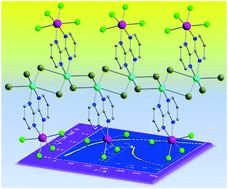当前位置:
X-MOL 学术
›
CrystEngComm
›
论文详情
Our official English website, www.x-mol.net, welcomes your feedback! (Note: you will need to create a separate account there.)
Halogen⋯halogen interactions in the self-assembly of one-dimensional 2,2′-bipyrimidine-based CuIIReIV systems†
CrystEngComm ( IF 3.1 ) Pub Date : 2018-07-13 00:00:00 , DOI: 10.1039/c8ce00996a Donatella Armentano 1, 2, 3, 4 , Adrián Sanchis-Perucho 5, 6, 7, 8 , Carlos Rojas-Dotti 5, 6, 7, 8 , José Martínez-Lillo 5, 6, 7, 8
CrystEngComm ( IF 3.1 ) Pub Date : 2018-07-13 00:00:00 , DOI: 10.1039/c8ce00996a Donatella Armentano 1, 2, 3, 4 , Adrián Sanchis-Perucho 5, 6, 7, 8 , Carlos Rojas-Dotti 5, 6, 7, 8 , José Martínez-Lillo 5, 6, 7, 8
Affiliation

|
Two one-dimensional CuIIReIV coordination polymers of the general formula {[ReIVCl4(μ-bpym)CuIIX2]·solvent}n [where bpym = 2,2′-bipyrimidine, X = Cl (1) and Br (2), and solvent = H2O (1) and CHCl3 (2)] have been prepared and characterised structurally and magnetically. Both compounds crystallise in the monoclinic system with space groups P21/c (1) and P21/n (2). Each CuII ion is bonded to two cis nitrogen atoms from the bpym ligand and to four halogen atoms. Two of these halogen atoms are placed in the equatorial plane and the other two are filling the axial positions of the CuII ion, thus generating a distorted octahedral environment for this metal ion in 1 and 2. In both compounds, the ReIV ion is six-coordinate and bonded to four chloride ions and two nitrogen atoms of the bpym ligand giving rise to a distorted octahedral geometry. In the crystal packing of both compounds, hydrogen bonds (1), short intermolecular ReIV–Cl⋯Cl–ReIV contacts (1 and 2), and X⋯π type interactions (1 and 2), the intermolecular interactions causing the self-assembly of these novel one-dimensional 2,2′-bipyrimidine-based CuIIReIV systems, are present. Variable-temperature magnetic measurements performed on microcrystalline samples of 1 and 2 reveal an antiferromagnetic behaviour for both compounds. Several magnetic interactions take place in 1 and 2, both intermolecular (ReIV–ReIV) and intramolecular (ReIV–CuII and CuII–CuII) magnetic exchanges, which account for the maxima observed in their respective magnetic susceptibility versus temperature curves at ca. 6.0 (1) and 18.0 K (2).
中文翻译:

一维基于2,2'-联嘧啶的Cu II Re IV系统自组装中的卤素⋯卤素相互作用†
两种{{Re IV Cl 4(μ-bpym)Cu II X 2 ]·溶剂} n的一维Cu II Re IV配位聚合物n [其中bpym = 2,2'-联嘧啶,X = Cl(1)和Br(2),溶剂= H 2 O(1)和CHCl 3(2)]的制备已经完成,并在结构和磁性上进行了表征。两种化合物均在具有空间群P 2 1 / c(1)和P 2 1的单斜晶系中结晶。/ n(2)。每个Cu II离子与bpym配体的两个顺式氮原子键合,并与四个卤素原子键合。这些卤素原子中的两个放置在赤道平面上,另外两个填充Cu II离子的轴向位置,因此在1和2中为该金属离子生成了扭曲的八面体环境。在这两种化合物中,Re IV离子均为六配位并键合到bpym配体的四个氯离子和两个氮原子上,从而导致扭曲的八面体几何形状。在这两种化合物的晶体堆积中,氢键(1),短分子间Re IV –Cl⋯Cl–Re存在IV接触( 1和2)和X⋯π型相互作用( 1和2),分子间相互作用导致这些新颖的基于一维2,2'-联嘧啶的Cu II Re IV系统自组装。。在1和2的微晶样品上进行的可变温度磁测量揭示了这两种化合物的反铁磁行为。在1和2中发生了几种磁相互作用,无论是分子间(Re IV –Re IV)还是分子内(Re IV –Cu II)和Cu II –Cu II)磁交换,这解释了它们在大约200 ℃时各自的磁化率与温度关系曲线中观察到的最大值。6.0(1)和18.0 K(2)。
更新日期:2018-07-13
中文翻译:

一维基于2,2'-联嘧啶的Cu II Re IV系统自组装中的卤素⋯卤素相互作用†
两种{{Re IV Cl 4(μ-bpym)Cu II X 2 ]·溶剂} n的一维Cu II Re IV配位聚合物n [其中bpym = 2,2'-联嘧啶,X = Cl(1)和Br(2),溶剂= H 2 O(1)和CHCl 3(2)]的制备已经完成,并在结构和磁性上进行了表征。两种化合物均在具有空间群P 2 1 / c(1)和P 2 1的单斜晶系中结晶。/ n(2)。每个Cu II离子与bpym配体的两个顺式氮原子键合,并与四个卤素原子键合。这些卤素原子中的两个放置在赤道平面上,另外两个填充Cu II离子的轴向位置,因此在1和2中为该金属离子生成了扭曲的八面体环境。在这两种化合物中,Re IV离子均为六配位并键合到bpym配体的四个氯离子和两个氮原子上,从而导致扭曲的八面体几何形状。在这两种化合物的晶体堆积中,氢键(1),短分子间Re IV –Cl⋯Cl–Re存在IV接触( 1和2)和X⋯π型相互作用( 1和2),分子间相互作用导致这些新颖的基于一维2,2'-联嘧啶的Cu II Re IV系统自组装。。在1和2的微晶样品上进行的可变温度磁测量揭示了这两种化合物的反铁磁行为。在1和2中发生了几种磁相互作用,无论是分子间(Re IV –Re IV)还是分子内(Re IV –Cu II)和Cu II –Cu II)磁交换,这解释了它们在大约200 ℃时各自的磁化率与温度关系曲线中观察到的最大值。6.0(1)和18.0 K(2)。



























 京公网安备 11010802027423号
京公网安备 11010802027423号